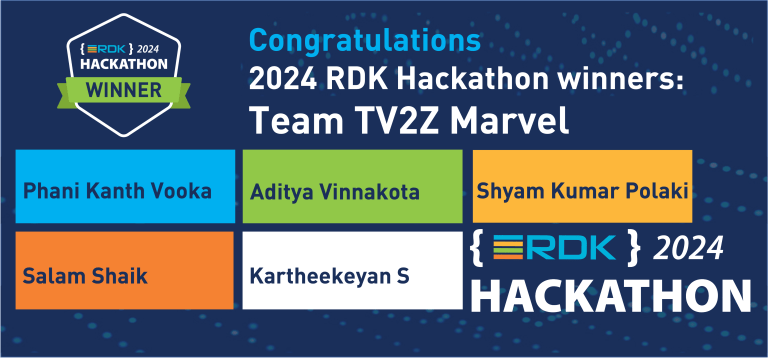
Be a part of the 2024 RDK Hackathon by submitting your feature, innovation, solution, or concept for the RDK code.
The winning team receives $2,500.
Team Registration
Dec. 11 – Jan. 12
Hackathon Period
Feb. 5 – March 15
Final Judging
April 1–5
Winner Announced
April 8
Team Registration
Hackathon Period
Final Judging
Winner Announced
Dec. 11 – Jan. 12
Feb. 5 – March 15
April 1–5
April 8
The winner of the 2024 RDK Hackathon is....

Rules
- Teams may be formed by any RDK licensee
- Create your own team of one to five members
- All entries submitted become the property of RDK
- Entries may be added to the RDK open source code
- Email questions to info@rdkcentral.com
Schedule
- December 11 — Registration opens; teams can submit their own concepts to RDK until December 21
- January 12 — Deadline for registration
- January 19 — RDK provides final approval for new concepts
- February 5 — Hackathon begins
- March 15 — Deadline for submitting projects
- April 1-5 — Finalist presentations to judges
- April 8 — Winner announced
- TBD — Winner presents at RDK Webinar
Concepts
You may choose from one of the following approved concepts submitted by RDK and our partner companies or submit a new concept of your own. New concepts will be reviewed for approval by RDK.
Concept 1: Bring “Simple IoT” or “Home Assistant” on RDK-B
Concept 1: Bring “Simple IoT” or “Home Assistant” on RDK-B
Integrate “Simple IoT” or “Home Assistant” framework in RDK-B. Participant can select which protocol (Zigbee, Matter, etc.)
Use Case:
User should be able to control the light bulb through the cloud.
Concept 2: IoT Client for RDK-V
Concept 2: IoT client for RDK-V
Application communicates with existing IoT gateways (Amazon Echo, Google HUB, Samsung SmartThings, etc.), and displays them on UI.
Example: https://developers.home.google.com/local-home/overview
Use Case:
Manage the IoT devices using RDK.
Concept 3: VPN Client Integration in RDK-B
Concept 3: VPN client integration in RDK-B
Bring up VPN client in RDK-B, demonstrate the device connectivity.
Example: https://github.com/OpenVPN
Use Case:
Provide enhanced security to RDK-B client devices.
Concept 4: Photo Streams
Concept 4: Photo Streams
RDK Photo Stream, which will allow user to display photos on their TV screen. User can choose to display photos in a slideshow or in a grid view.
Use Case:
Customizable RDK Screen saver.
Concept 5: Design your own Firebolt App
Concept 5: Design your own Firebolt App
Create a native app that plays AV in the container mode with Rialto. It should use the Firebolt Native SDK for lifecycle management.
Use Case:
First Firebolt compatible native app.
Concept 6: Guest Wi-Fi Network
Concept 6: Guest Wi-Fi Network
Create a separate Wi-Fi network for guests, which is isolated from your main network and protects your personal data.
Demonstrate:
- Limit the bandwidth that is available to guests
- Parental controls on the guest network to block certain websites or types of content
Use Case:
Protect your personal data and devices, and control access.
Concept 7: TEE Application
Concept 7: TEE Application
Write an OP-TEE application on the RPI-4 platform.
Example in RPI-3: https://optee.readthedocs.io/en/latest/building/devices/rpi3.html, participant should bring this on RPI-4 https://github.com/OP-TEE/optee_os/issues/3205.
Use Case:
Increase the security, especially for IoT business.
Concept 8: Port RDK-B on Banana pi R3
Concept 8: Port RDK-B on Banana pi R3
Port RDK-B on Banana Pi R3 platform.
Demonstrate:
- RDK-B stack should be up and running in the device with minimal services required for wan bring up.
- Device should get Wan connectivity and launch web UI and connect to Wi-Fi.
Use Case:
To explore the feasibility of bringing up RDK-B in generic MediaTek chipsets.
Concept 9: Port RDK-V on Raspberry pi 5
Concept 9: Port RDK-V on Raspberry pi 5
Port RDK-V on Raspberry pi 5 platform.
Demonstrate:
- Basic AV playback
Use Case:
Bring RDK-V on the latest RPI 5
Judging Criteria:
All projects will be reviewed by an internal RDK team which will select 3 finalists. The finalists will present to a panel of judges for final judging and selection of one winner.
Judging Rubric:
Clarity of stated goal — up to 5 points
Extent to which stated concept is achieved — up to 10 points
Quality of final code submitted — up to 20 points
Performance of product or feature — up to 20 points
Quality of supporting documentation — up to 10 points
Quality of final presentation — up to 5 points
Complexity of design — up to 5 points
Total maximum points: 75
